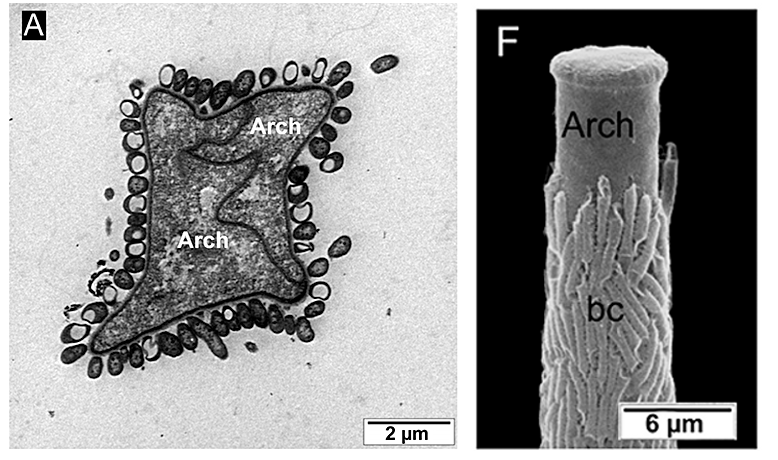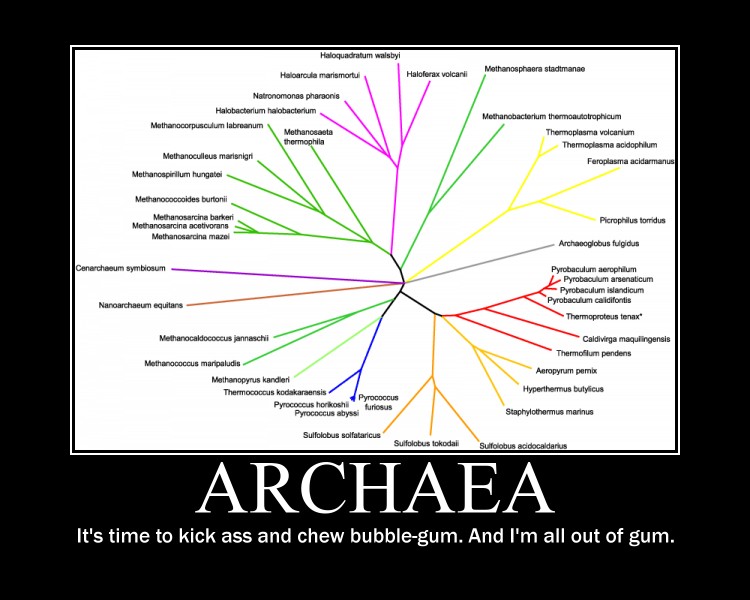Attack of the Giant Archaea
Archaea are under-rated. For one, most people don’t really know they exist – and if they do archaea are thought of as a type of bacteria. This goes not only for the general public also for some of my non-microbiology colleagues. (I had to correct quite a few “archaeobacteria” utterances.) The discovery that Archaea are a separate domain of life, as far from bacteria as we are, has never properly embedded itself in the way people commonly perceive life. There are some mitigating circumstances of course: anyone can intuitively understand the difference between Salmonella and a tiger; but you need to have a more specialized knowledge base to appreciate the difference between Methanococcus (an archaeon) and Salmonella, and understanding this difference is not an intuitive thing . Even in some textbooks for freshman biology, when addressing the diversity of life, it seems that Archaea are relegated to a status of driving the shoulders of the bacterial highway. Indeed the text usually goes through the formalities of explaining that archaea are a separate domain, and may even draw a nice three-lobed tree to illustrate the concept. But even after reading that, one is left with the feeling that the authors did not really believe what they were saying. The perceived subtext is that archaea are basically those weird non-bacteria (but they kinda are) that live in weird places like the Dead Sea, hot springs in Yellowstone, cow guts, and the arctic circle’s permafrost.
![]()
They are not THAT interesting since they don’t really affect our health, aside from causing farts. Hahaha. And much like the population of a faraway land which appears in the news only in the event of a natural disaster or the birth of a two-headed boy, they tend to be appreciated for contributing a certain spice to the microbial world, rather than being strong contributers and essential elements of the biosphere. It is the lack of perceptible distinctiveness, and the perceived exoticness and lack of impact on human affairs have marginalized archaea, even among microbiologists. (Hard to justify an R01 for studying archaea.)
Let’s fix these misperceptions. For one thing, archaea are everywhere. Soil, marshland & oceans – it is estimated they make up some 20% of the oceanic microbial plankton.
Another thing: archaea affect our planet, and as a consequence, us, profoundly. One example is the role of methanogens in carbon release to the atmosphere. Methane is a greenhouse gas 20 time as potent as carbon-dioxide.
Archaea are different: unlike bacteria, their cell walls do not have peptidoglycan, their membrane biochemistry is different than anything else on earth.
Archaea also interact with other species: other archaea and bacteria. We have not heard of archaeal parasites or pathogens yet, but there are plenty of commensals and mutualists out there.
One really cool example was recently published in Environmental Microbiology. A giant marine archaea that lives in the shallow waters of the French West indies. (Got to hand it to the authors, they know how to pick a good research spot.) Specifically, near the roots of mangroves. There is a whole ecosystem going on down there. The archaea form long filaments, 0.1mm thick and 30mm long. The filaments are wrapped around the roots of the mangroves. The individual archaea cells are huge! 0.1 mm is almost visible to the naked eye, and the filaments themselves are visible. Here’s the kicker though: the archaeal filaments are coated with bacteria, which are much smaller. Under the microscope, the whole structure looks like a plant stalk covered with aphids. The bacteria coating the archaeal filaments also contain sulfur globules, which may indicate some symbiotic relationship between the bacteria and the archaea regarding sulfur. In any case, what we have here seems to be a rather complex and fascinating structure, with giant archaea and small bacteria doing…, er… something together.

A. Cross section of the archaeal filament, showing two archaeal cells separated by the zig-zagging line. The circles around are sulfur-containing bacteria. (F) scanning electron microscope of the giant archaeal filament (Arch) coated with bacteria (bc). From Muller et. al Env Microbiol (2010) 12:8 2371- (c)2010 Society for Applied Microbiology and Blackwell Publishing Ltd.
Note to the authors (on an otherwise excellent paper): please don’t use the phrase “98.4% sequence homology”….
Muller, F., Brissac, T., Le Bris, N., Felbeck, H., & Gros, O. (2010). First description of giant Archaea (Thaumarchaeota) associated with putative bacterial ectosymbionts in a sulfidic marine habitat Environmental Microbiology, 12 (8), 2371-2383 DOI: 10.1111/j.1462-2920.2010.02309.x




















I thot that we are archaeans.. and bacteria. Isn’t the Eukarya a reticulate taxon, comprised of an archaean cell parasitized by various bacteria? Doesn’t that “nice three-lobed tree” have a dotted line connecting Bacteria with Eukarya, after the node where Archaea & Eukarya split? If we are equally far from archaeans & bacteria, aren’t those two groups twice as far from one another than either is from us?
Well, there is the hypothesis of nucelar symbiosis, that eukaryal nuclei are archaeal in origin, and they “endosymbiotized” (uh, probably not the right term) into a bacterial cell to form a eukaryote. These two papers make interesting points using some bioinformatics and tree topology analyses: http://www.nature.com/ncb/journal/v3/n2/full/ncb0201_210.html
http://www.nature.com/nature/journal/vaop/ncurrent/abs/nature02848.html
I’m not sure how decisive archaeal + bacterial –> eukaryotre hypothesis is. then again, I do not claim to be an expert on the subject of ancient evolution, so maybe someone else can weigh in.
that’s what i thunked too – archaeal nucleus with (“parasitized” – nice ) eubacterial mitochondria or chloroplasts….
*twitch* Archaean ancestry of eukaryotes is FAR from settled, guys! Thus far, evidence actually supports them to be sister groups, although some trees (but fewer and fewer) still show Archaea as paraphyletic. It makes little sense for eukaryotes to magically revert back to the eubacterial-type plasma membrane; it makes a lot more sense for Archaeans to have a highly derived membrane instead, considering they’re actually likely a fairly recent group (~1-1.5 billion years, like eukaryotes) and had to adapt to extreme environments in their past (with some mesophilic forms arising later).
Also, the only thing supporting eubacterial monophyly are SSU phylogenies and some gene trees. That model is very difficult to explain with cell biology and biochemistry, and thus that too remains far from settled. I wish people stopped worshipping molecular trees someday, and looked at the evidence holistically…
Thus, one can legitimately maintain that archaea and eukarya are just a couple more phyla of bacteria ^^ Archaea are cool and unique, but so are the various Proteobacteria, Chloroflexi, Actinobacteria, Thermotogales, etc. I think many people underestimate the extent of diversity of the less glorified ‘eubacteria’…
Oh, and the ‘ring of life’ thing… let’s just say weird evol theories are helluvalot easier to publicise than the usual story of drift, selection and mutational bias. Look at the popularity of Margulis’ Everything Symbiosed Together Into One Big Ass Mess of a Cell Theory, outside the actual field in question that is. An endosymbiotic origin of the flagellum is waaay cooler than an autogenic one, so modern textbooks still insist on including it, despite there being next to no evidence supporting it. Same thing for the Ring of Life (w eubacteria ingesting archaea to make nucleus, etc), IMO.
Btw, I’m no expert on this stuff either, just happen to enjoy reading on the subject. If interested, I’d recommend Cavalier-Smith 2006 Biol Direct for a non-mainstream (yet very tame and sensible) view of bacterial evolution and the origin of eukaryotes, as well as Cavalier-Smith 2009 J Eukaryotic Microbiology for more on the latter. Koonin had a recent review this spring on eukaryogenesis, but he intentionally ignored the eubacterial paraphyly hypotheses, and that kind of thing pisses me off, so I don’t recommend reading it. Grrr… (could’ve at least mentioned them and said he doesn’t believe them, etc. But outright ignoring competing ideas is just sloppy review authorship)
As for the post, microbial symbiosis is so awesome, isn’t it? I’m glad that finally more people approach microbial ecosystems in a community ecology approach — ie, that the various members of the system interact with each other much like animals and plants and other glorified big things do. Protists also form amazing symbioses with prokaryotes, and really the microbial interaction web is outright breathtaking. One thing is seeing random sequences floating about, but the true wonders of microbial ecology become evident only when treating microbes as bona fide organisms, which they inarguably are!
@Psi Wavefunction The only comment I want to make on holistic evidence, is that in my experience the majority of people working on the question of origin of eukaryotes actually do consider things like composition of the plasma membrane in situating their hypotheses and in interpreting the molecular evidence. The same is true, for example, on the question of Excavate monophyly. That said there IS a reason why properly done molecular phylogenies should be considered to be more reliable (the key word here being proper, you have to assume you are using an appropriate model) and that has to do with the statistical rigor of the analysis.
As for the exact Archeal/Eukaryote relationship I don’t think I would say fewer and fewer trees show Archeal paraphyly with the Eukaryotes. But yes, it is certainly far from settled but the papers in support of it (Check a recent post at Not Exactly Rocket Science for a selection plus those by Martin Embley) are quite good. So to are the ones by TC-S that you mention as well.
*also twitch* what psi said! I’m slightly worried that the idea of bacteria + archaea = eukaryote seems to be spreading. It is by no way a settled idea! There are elements of both bacteria and archaea in eukaryotes, but you could equally say there are elements of bacteria and eukaryotes in archaea…
This was a brilliant post, it’s great to see the often-ignored archaea getting some more love. I love the electron micrograph as well, the difference in sizes amongst the Very Small is another thing that doesn’t get enough press.